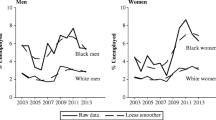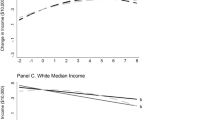Abstract
This paper develops and tests hypotheses about the impact of opportunity structures on black fertility across local labor markets. US Vital Statistics and Census of Population data are combined and then examined with regression techniques to estimate the effect of both race-specific and relative measures of opportunity structure on black fertility in the United States. The results show that relative female opportunity structure has a negative relationship with black total fertility rates as well as with birth rates for specific points along the reproductive age structure. However, the hypothesized relationship between relative male opportunity structures and black fertility is not supported. We discuss these results as they relate to minority fertility theory and as they relate to public policy concerns.
Similar content being viewed by others
References
Bean, F.D. & Swicegood, G. (1985). Mexican American fertility patterns. Austin, TX: University of Texas Press.
Bean, F.D. & Marcum, J.P. (1978). Differential fertility and the minority group status hypothesis: An assessment and review, in: F.D. Bean & W.P. Frisbie (eds.), The demography of racial and ethnic groups, pp. 189–212. New York: Academic Press.
Belsey, D.A., Kuh, E. & Welsch, R.E. (1980). Regression diagnostics. New York: John Wiley.
Billy, J.O.G. & Moore, D.E. (1992). A multilevel analysis of marital and nonmarital fertility in the US, Social Forces 70: 977–1012.
Blau, P. & Duncan, O.D. (1967). The American occupational structure. New York: John Wiley.
Burr, J.A. (1995). Metropolitan social structure, labor markets, and fertility, Social Indicators Research (in press).
Burr, J.A. & Bean, F. (1994). Racial fertility differences: The role of female employment and education in wanted and unwanted childbearing. Unpublished manuscript.
Burr, J.A., Galle, O.R. & Fossett, M.A. (1991). Racial occupational inequality in southern metropolitan areas, 1940–1980: Revisiting the visibility-discrimination hypothesis, Social Forces 69: 831–850.
Cain, G.G. & Weininger, A. (1973). Economic determinants of fertility: Results from crosssectional aggregate data, Demography 10: 205–223.
Cain, G.G. & Dooley, M.D. (1976). Estimation of a model of labor supply, fertility, and wages of married women, Journal of Political Economy 84: 179–199.
Cleveland, W.S. & Devlin, S.J. (1988). Locally weighted regression: An approach to regression analysis by local fitting, Journal of the American Statistical Association 83: 596–610.
Collver, O.A. (1968). Women's work participation and fertility in metropolitan areas, Demography 5: 55–60.
Duncan, B. & Lieberson, S. (1970). Metropolis and region in transition. Beverly Hills: Sage Publications.
Easterlin, R.A. (1968). Population, labor force, and long swings in economic growth: The American experience. New York: Columbia University Press.
Easterlin, R. (1980). Birth and fortune: The impact of numbers on personal welfare. New York: Basic Books.
Farley, R. (1984). Blacks and whites: Narrowing the gap? Cambridge, MA: Harvard University Press.
Farley, R. (1988). After the starting line: Blacks and women in an uphill race, Demography 25: 477–495.
Farley, R. & Allen, W.R. (1987). The color line and the quality of life in America. New York: Russell Sage Foundation.
Fossett, M.A., Galle, O.R. & Kelly, W. (1986). Racial occupational inequality, 1940–1980: National and regional trends, American Sociological Review 51: 421–429.
Fossett, M.A. & Kiecolt, K.J. (1991). A methodological review of the sex ratio: Alternatives for comparative research, Journal of Marriage and the Family 53: 941–957.
Frey, W. & Speare, A. Jr. (1988). Regional and metropolitan growth and decline in the United States. New York: Russell Sage Foundation.
Goldscheider, C. & Uhlenberg, P. (1969). Minority group status and fertility, American Journal of Sociology 74: 361–372.
Grant, D.S., II & Parcels, T.L. (1990). Revisiting metropolitan racial inequality: The case for a resource approach, Social Forces 68: 1121–1142.
Heer, D. & Boynton, J.W. (1970). A multivariate regression analysis of differences in fertility in US counties, Social Biology 17: 180–194.
Hogan, D.P. & Kitagawa, E.M. (1985). The impact of social status, family structure, and neighborhood on the fertility of black adolescents, American Journal of Sociology 90: 825–855.
Johnson, N.E. (1979). Minority group status and the fertility of black Americans, 1970: A new look, American Journal of Sociology 84: 1386–1400.
Kasarda, J. & Billy, J.O.G. (1985). Social mobility and fertility, Annual Review of Sociology 11: 305–328.
Land, K.C., McCall, P.L. & Cohen, L.E. (1990). Structural covariates of homicide rates: Are there any invariances across time and space, American Journal of Sociology 95: 922–963.
Lieberson, S. (1975). Rank-sum comparisons between groups, pp. 276–91, in: K. Schuessler (ed.), Sociological research methods. San Francisco: Jossey-Bass.
Mason, K.O. & Palan, V.T. (1981). Female employment and fertility in peninsular Malaysia: The maternal role incompatibility hypothesis reconsidered, Demography 18: 549–575.
Mellor, E.F. & Stamas, G.O. (1982). Usual weekly earnings: Another look at intergroup differences and basic trends, in: Bureau of Labor Statistics, Analyzing 1981 earnings data from the current population survey, pp. 15–24. September, Bulletin No. 2149.
National Center for Health Statistics (1984). Vital statistics of the United States, Vol. 1: Natality. DHHS Pub. No. (PHS) 85–110. Washington, DC: US Government Printing Office.
Ritchey, P.N. (1975). The effect of minority group status on fertility: A re-examination of concepts, Population Studies 29: 249–257.
Rousseeuw, P.J. & Leroy, A.M. (1987). Robust regression and outlier detection. New York: John Wiley.
Shryock, H.S. & Siegel, J.S. (1976). The methods and materials of demography. New York: Academic Press.
South, S.J. (1988). Sex ratios, economic power, and women's roles: A theoretical extension and empirical test, Journal of Marriage and the Family 50: 19–31.
South, S.J. & Lloyd, K.M. (1992). Marriage markets and nonmarital fertility in the United States, Demography 29: 247–264.
Stolzenberg, R.M. & Waite, L.J. (1981). Labor market characteristics and the labor force participation of individuals. The Rand Paper Series, No. 6705.
Turchi, B. (1975). Microeconomic theories of fertility: A critique, Social Forces 54: 107–125.
US Bureau of the Census (1982). State and metropolitan area data book, 1982. Washington, DC: US Government Printing Office.
US Bureau of the Census (1983). Census of population and housing: Characteristics of the population (state volumes). Washington, DC: US Government Printing Office.
White, L.K. (1979). The correlates of urban illegitimacy in the United States, 1960–1970, Journal of Marriage and the Family 41: 715–726.
Wilson, W.J. (1987). The truly disadvantaged. Chicago: University of Chicago Press.
Author information
Authors and Affiliations
About this article
Cite this article
Burr, J.A., Hartman, J. Racial opportunity structures and black fertility. Popul Res Policy Rev 15, 75–94 (1996). https://doi.org/10.1007/BF00156743
Issue Date:
DOI: https://doi.org/10.1007/BF00156743




